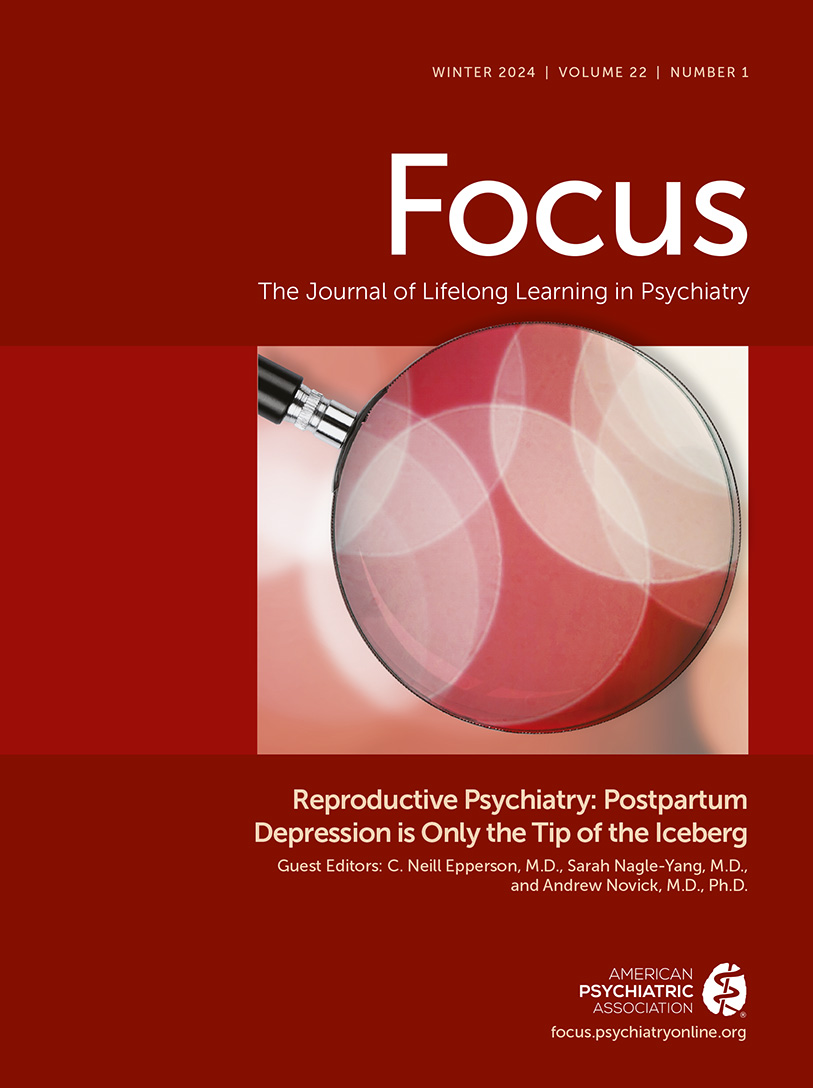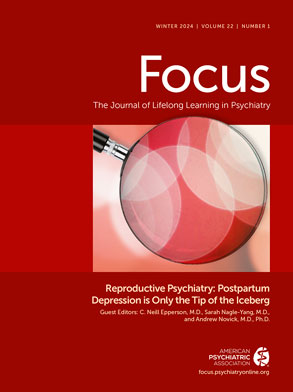Steroid Contraception
Between 2017 and 2019, 65.3% of females ages 15–49 were using some form of steroid contraception (
10), making these agents the most common co-occurring medication to consider when evaluating women in psychiatric practice. Although the majority of studies focusing on steroid contraceptives assume participants are females who identify as women, steroid contraceptives can be utilized as part of gender-affirming care and should be considered for their potential to alter mood. The term female is utilized below to refer to individuals who were identified as female at birth.
Most oral contraceptive pills (OCPs) are a combination of ethinyl estradiol and a progestin, which, together, suppress ovarian hormone production, leading to drastic reductions in 17-beta estradiol, the most potent naturally occurring estrogen, and progesterone, which is the body’s main source of allopregnanolone. Because the majority of progestins are not metabolized to allopregnanolone, both oral and implanted steroid contraceptives deprive the female brain of ovarian sources of this GABAA receptor–modulating neurosteroid.
Teasing apart whether symptoms of depression, anxiety, or irritability are due to the use of OCPs or whether they could ameliorate such symptoms is difficult in psychiatric practice without the use of daily mood and behavior ratings. Without documentation, patient and provider assessments of mood and behavioral symptoms in relationship to the menstrual cycle phase are unreliable. Likewise, psychiatric and medical history needs to focus on the timing of psychiatric symptoms in relationship to initiation of steroid contraception or a change in contraception method.
Luckily, many of those who are identified as female at birth report no change or improvement in mood and well-being with the initiation of OCPs, contraceptive implants, and the progestin-emitting intrauterine device (IUD), including those who have a history of major depressive disorder or premenstrual worsening of depression (
11,
12). Nevertheless, a sizable group will report onset of depressive symptoms and worsening of premenstrual dysphoric disorder symptoms with these exogenous steroids. A large epidemiologic study from northern Europe indicated that the diagnosis of major depressive disorder, suicidal ideation and/or attempt, and psychiatric hospitalizations all increased in the year after initiating a steroid contraceptive method, particularly among female adolescents and young adults (
13).
However, OCPs containing the anti-androgenic progestin drospirenone have been approved by the Food and Drug Administration (FDA) for the treatment of PMDD and may be a first-line choice of treatment for individuals with PMDD who also require contraception. Overall, selective serotonin reuptake inhibitors (SSRIs) are the gold-standard treatment for PMDD when used daily, during the luteal phase, or at the time of symptom onset. Confirmation of PMDD diagnosis by prospective daily ratings is critical before attempting to initiate a luteal-phase or symptom-onset SSRI treatment regimen.
Other alternatives to OCPs are progestin-containing implants and IUDs. The hormonal IUD is thought to have less of an effect on ovarian hormone production and, thus, fewer negative effects on mood, although some epidemiologic studies suggest that the opposite may be true, particularly in younger females (
14). A recent study suggested that mood was improved among females using the progestin implant a year after use, although the individuals studied did not meet criteria for major depressive disorder at baseline (
15).
In summary, after a careful assessment of symptoms with preferably 2 months of daily ratings, it is reasonable to suggest that an individual discontinue the steroid contraceptive and continue to monitor symptoms if the steroid contraceptive method is suspected in the onset or worsening of her psychiatric symptoms. Alternatively, if psychiatric symptoms are not related to the onset of steroid contraceptive use, and the severity of symptoms suggests the need for other pharmacotherapy, evidence-based psychopharmacology and/or psychotherapies are recommended. Any suggestion of discontinuing steroid contraception should emphasize the importance of alternative contraception to minimize the risk for unintended pregnancy.
Menopause Hormone Therapy (HT)
There is no one experience of being peri- or postmenopausal. Perimenopause can extend over a decade, with culmination in the final menstrual period at the age of 51, on average. Many women sail through the transition without significant vasomotor symptoms or changes in mood, whereas a large percentage experience severe and prolonged hot flashes, sleep disruption, cognitive difficulties, depression, anxiety, and (rarely) psychosis. These symptoms peak during perimenopause and then decline in the years postmenopause, particularly if the individual undergoes a natural menopause within the average age range. Those who undergo a premature postmenopause (at ≤40 years of age) or a surgical menopause experience more severe and prolonged symptoms (
21,
22). On average, Black women and those with premenstrual mood disorder (determined by retrospective report) appear to have earlier onset of perimenopause and greater severity or duration of vasomotor symptoms (
23,
24). Health and lifestyle factors such as cigarette smoking history can affect the timing of menopause.
As these brain-related symptoms are quite common and they negatively affect quality of life, it is critical for the psychiatrist treating females in their fourth and fifth decades to keep in mind that their patients may experience worsening or new onset of symptoms caused by the hormonal flux associated with the menopause transition. A regular review of systems that includes menstrual cycle history should reveal whether an individual is peri- or postmenopausal. It is important to have a low threshold for adjusting standing psychotropic medications or starting new ones if the patient is experiencing symptoms that negatively affect their quality of life.
Understandably, most general psychiatrists are not comfortable initiating HT with their patients, but they can identify which of their patients may benefit from HT and make a referral to a primary care provider or gynecologist for further evaluation. Currently, there is evidence from two randomized controlled trials that estrogen treatment (ET) is more effective than placebo in the treatment of depressive disorders during the perimenopause (
25,
26). For those with no contraindications to HT, ET is the gold-standard treatment for vasomotor symptoms and vulvovaginal atrophy, and females may experience an improvement in sleep, cognition, and sexual function with ET. If a female undergoes a premature menopause or a surgical menopause but has not had cancer, ET is a viable and important option. Overall, the North American Menopause Society (
27) guidelines for the use of HT during the menopause transition emphasize the use of HT and/or ET for symptomatic females who are ages 60 years or younger and proximal to the last menstrual period, as the risk-benefit balance is less optimal during later years.
It is important for psychiatrists to remember that it is not uncommon for individuals to experience onset of executive function difficulties during perimenopause, and those with surgical menopause are likely to be even more severely affected (
21). The psychostimulant lisdexamfetamine is a reasonable option for symptomatic relief (
28), although there are reports of some individuals having difficulties with insurance coverage for the medication because they do not meet the criterion of childhood onset for attention-deficit hyperactivity disorder.
In summary, general psychiatrists can appreciate the profound impact that gonadal steroids have on the brain and behavior, even if they have not received specialized training in reproductive psychiatry. Careful consideration of menstrual cycle history, pharmacologic or surgical manipulation of endogenous gonadal steroid production, and exogenous administration of ovarian steroids or their analogs will enable the psychiatrist to tease out the possible contribution of these manipulations to their patient’s psychiatric presentation. Ultimately, female patients will benefit from these considerations, as their psychiatric care will be hormone informed; and some may find symptom relief with the initiation, change, or discontinuation of a hormone regimen. Because there are relatively little data regarding the impact of gonadal steroid manipulations and their effect on psychiatric symptoms outside of the resolution of gender dysphoria among those who do not identify as cisgender and heterosexual, the psychiatrist has less evidence to guide their decision making in this population. However, patients will appreciate the hormone-informed evaluation, and future research ideally will provide greater guidance regarding the effects of gender-affirming hormonal care on the brain and behavior across a range of psychiatric contexts.

